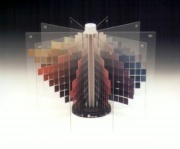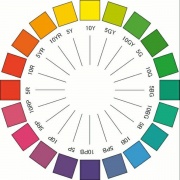Difference between revisions of "Munsell color system"
(username removed) |
|||
| (One intermediate revision by one other user not shown) | |||
| Line 1: | Line 1: | ||
[[File:munsellmodel.jpg|thumb|Munsell model]] | [[File:munsellmodel.jpg|thumb|Munsell model]] | ||
== Description == | == Description == | ||
| − | + | [[File:MunsellColorWheel.jpg|thumb|Munsell Color Wheel]] | |
A color notation system begun in 1898 by Albert H. Munsell, a lecturer in color composition and art at the Normal Art School in Boston as a teaching aid in his color composition class. Munsell published the full system in 1905 in his book titled Color Notation. The Munsell system uses sets of color chips for visual comparison of hue, value, and chroma. | A color notation system begun in 1898 by Albert H. Munsell, a lecturer in color composition and art at the Normal Art School in Boston as a teaching aid in his color composition class. Munsell published the full system in 1905 in his book titled Color Notation. The Munsell system uses sets of color chips for visual comparison of hue, value, and chroma. | ||
| Line 10: | Line 10: | ||
Chroma is a measure of the saturation (or purity) of a color. The maximum chroma, or 100 percent pure color, can have numbers of about 18-20. Weakly saturated colors can have chromas of about 2. The constant hue charts are prepared with regular progression from achromatic colors (black, gray, or white) at the left side of each chart to saturated colors on the right side. | Chroma is a measure of the saturation (or purity) of a color. The maximum chroma, or 100 percent pure color, can have numbers of about 18-20. Weakly saturated colors can have chromas of about 2. The constant hue charts are prepared with regular progression from achromatic colors (black, gray, or white) at the left side of each chart to saturated colors on the right side. | ||
| − | |||
== Synonyms and Related Terms == | == Synonyms and Related Terms == | ||
| Line 17: | Line 16: | ||
== Additional Information == | == Additional Information == | ||
| − | + | * Munsell Color Company: [https://munsell.com/ Website] | |
| − | + | * Munsell Color Science Laboratory at the Rochester Institute of Technology: [https://www.rit.edu/facilities/munsell-color-science-laboratory Website] | |
* Ralph Mayer, ''A Dictionary of Art Terms and Techniques'', Harper and Row Publishers, New York, 1969 (also 1945 printing) | * Ralph Mayer, ''A Dictionary of Art Terms and Techniques'', Harper and Row Publishers, New York, 1969 (also 1945 printing) | ||
| − | * Website | + | * Website: http://www.arce.ukans.edu/book/color/classif.htm |
* Thomas B. Brill, ''Light Its Interaction with Art and Antiquities'', Plenum Press, New York City, 1980 | * Thomas B. Brill, ''Light Its Interaction with Art and Antiquities'', Plenum Press, New York City, 1980 | ||
| − | * Wikipedia | + | * Wikipedia: http://en.wikipedia.org/wiki/Munsell_Colour_System (Accessed Sept. 10, 2005) |
[[Category:Materials database]] | [[Category:Materials database]] | ||
Latest revision as of 16:03, 1 October 2022
Description
A color notation system begun in 1898 by Albert H. Munsell, a lecturer in color composition and art at the Normal Art School in Boston as a teaching aid in his color composition class. Munsell published the full system in 1905 in his book titled Color Notation. The Munsell system uses sets of color chips for visual comparison of hue, value, and chroma.
Hue is the name of a color. Munsell uses ten major divisions of hue: R-Red; BG-BlueGreen; YR-YellowRed B-Blue; Y-Yellow PB-Purble Blue; GY-GreenYellow P-Purple; G-Green; RP-RedPurple
Value is a measure of the lightness or darkness of a color on a scale of 0-10. A high value represents a light color with a high daylight reflectance. Ten is ideal white. A low value indicates darker colors and lower daylight reflectance. Zero represents ideal black.
Chroma is a measure of the saturation (or purity) of a color. The maximum chroma, or 100 percent pure color, can have numbers of about 18-20. Weakly saturated colors can have chromas of about 2. The constant hue charts are prepared with regular progression from achromatic colors (black, gray, or white) at the left side of each chart to saturated colors on the right side.
Synonyms and Related Terms
Munsell system; color order system
Additional Information
- Munsell Color Company: Website
- Munsell Color Science Laboratory at the Rochester Institute of Technology: Website
- Ralph Mayer, A Dictionary of Art Terms and Techniques, Harper and Row Publishers, New York, 1969 (also 1945 printing)
- Thomas B. Brill, Light Its Interaction with Art and Antiquities, Plenum Press, New York City, 1980
- Wikipedia: http://en.wikipedia.org/wiki/Munsell_Colour_System (Accessed Sept. 10, 2005)

